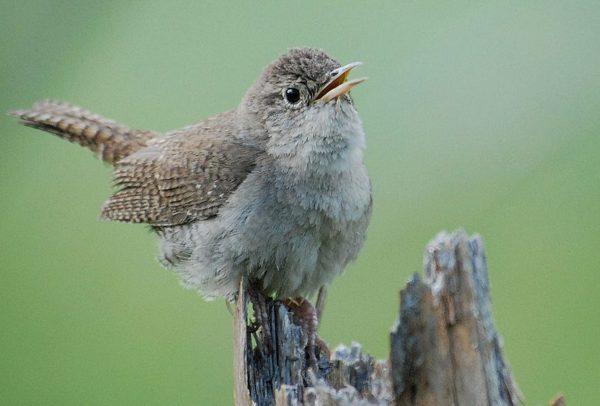Information About The Bird
Seen/Heard at
Decorah, Decorah North
Diet
House Wrens glean for food in the foliage of trees, shrubs, and bushes. They eat almost exclusively insects and spiders, including beetles, caterpillars, earwigs, daddy longlegs, flies, leafhoppers, and springtails: an insectivorous diet that requires them to fly south for the winter.
Nesting
House Wrens breed from late April through early September. The male begins constructing the nest by building a pile of twigs. Once he pairs with a female, she takes over. Depending on the stage of construction, she may add more twigs, create a shallow depression for eggs, or line the nest with feathers, grasses, hair, spider egg sacs, string, snakeskin, and discarded plastic. She will lay three to ten tan eggs speckled with brown per clutch and produce up to two broods per year. Female House Wrens incubate eggs for 9-16 days and young stay in the nest for 15-17 days before fledging. Both sexes feed young. To learn more, visit Cornell’s website.
Some people like House Wrens and others don’t. While their energetic behavior, jaunty tail, toleration of humans, and bubble song appeal to many people, they are fiercely territorial and will destroy the nests of other birds on their territory. More about that here: https://www.saintpaulaudubon.org/two-faces-house-wrens/.
Citations
Bird Range Maps of North America
Ridgely, R.S., T.F. Allnutt, T. Brooks, D.K. McNicol, D.W. Mehlman, B.E. Young, and J.R. Zook. 2003.
Digital Distribution Maps of the Birds of the Western Hemisphere, version 1.0. NatureServe, Arlington, Virginia, USA. Data provided by NatureServe in collaboration with Robert Ridgely, James Zook, The Nature Conservancy – Migratory Bird Program, Conservation International – CABS, World Wildlife Fund – US, and Environment Canada – WILDSPACE.
Web Link: http://bit.ly/2ynPQ5I
The Cornell Lab of Ornithology Birds of North America: https://birdsna.org/Species-Account/bna/species/houwre/introduction
General Description
House Wrens are a brownish gray overall, with darker barring on the wings and tail, dark eyes, brownish legs, and short wings.
Migration
House Wrens spend the summer in the Decorah area, nesting and raising young before migrating south to the southern United States and Mexico. They depart for their wintering grounds between mid-September and mid-November.
Measurements
Length: 4.3-5.1 in/11-13 cm
Wingspan: 5.9 in/15 cm
Weight: 0.3-0.4 oz/10-12 g
Wing Design
Elliptical. Optimized for bursts of fast, tightly controlled flight. Excellent at taking off quickly, maneuvering through branches, and avoiding predators.
| See also different: | Decorah Nest, Wrens |
